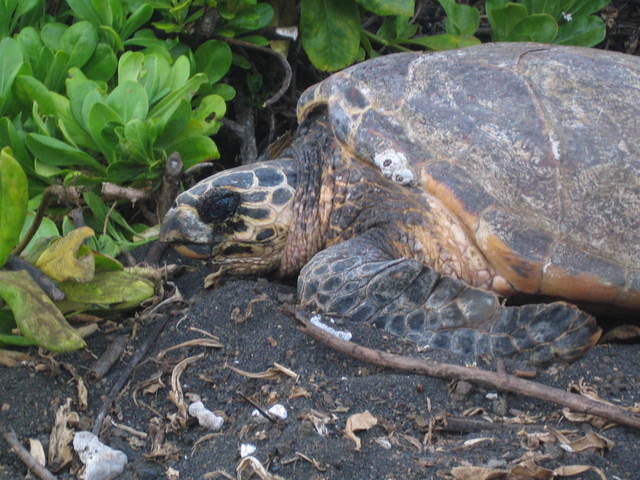Rare hawksbill turtles return
Over the next several months, the Big Island is expected to have several visitors from the sea. Chances are, though, these visitors won’t be seen by many.
ADVERTISING
Nesting season for the rare hawksbill turtle began last month and continues through December. The species is far less common than its relative the green sea turtle, as its population has been decimated by overhunting. But recovery efforts here persist.
“They’re extremely, extremely rare, and a lot of people don’t even know about them,” said Lauren Kurpita, project coordinator for the Hawksbill Recovery Project. “It’s an amazing species that hopefully we can keep on protecting.”
The recovery project, based out of Hawaii Volcanoes National Park, began in 1989 and concentrates its work around nesting season.
It’s the only time that hawksbill turtles come ashore. Unlike honu, which frequently come to beaches to bask, hawkbills spend their entire lives in the water.
“The only time they come on land is to nest,” Kurpita said. Males do not come ashore at all.
Hawksbill nesting takes place at night.
“The only reason we know that is because we’re out there monitoring,” Kurpita said. Monitoring takes place from 5 p.m. to 2 a.m. Project volunteers also walk the beaches during the day to check for the tracks of turtles that have come ashore during the night.
Though hawksbills lay several clutches of eggs when they nest — each containing about 180 eggs — they do not need a large amount of space to do so.
“They can just use pockets of sand,” Kurpita said.
Most monitoring takes place along the coastline of Hawaii Volcanoes National Park into the Ka’u district. According to the United States Fish and Wildlife Service, hawksbills also nest on Maui, Molokai and Oahu. But their primary destination is the Big Island — more than 90 percent of documented nesting to date has taken place here, Kurpita said.
Since 1989, 129 nesting individual hawksbill females have been identified. Between five and 15 individuals will come ashore in a given season.
“Once they nest, they’re not going to come back for another three to five years,” Kurpita said.
Though hawksbill return regularly to their nesting sites, the population has been slow to recover. Adults don’t mature until they are at least 20 years old, and getting to that point is a challenge in itself. Hatchlings are subject to predation from the moment they dig themselves out of their nests and make their way to the surf zone. They are highly sensitive to light and Kurpita recommends that anyone camping on a beach where nests are located avoid using bright white lights.
“Red light is better,” she said. “That’s a lot less harsh.” She also advises against driving on nesting beaches; tires can pack down nests and make it more difficult for hatchlings to get out.
Adult hawksbill populations have suffered in large part because of hunting: their carapaces are used to create tortoiseshell-pattern materials. The Fish and Wildlife Service reports that more than one million hawksbill turtles have been killed for their shells since 1970, though trade is now illegal.
Local populations of honu, however, are on their way to recovery; a recent proposal from FWS and the National Oceanic and Atmospheric Association this spring would reclassify the Hawaiian population as threatened, not endangered. The recommendation came because of a longterm uptick in nesting behavior.
A species listed as threatened is “not presently in danger of extinction, but is likely to become so in the foreseeable future,” according to the proposal.
In an e-mail to the Tribune-Herald, Patrick Opay of NOAA said that there have been measured long-term increases in populations at the honu’s primary nesting sites in the French Frigate Shoals.
“The population around Hawaii is doing better,” he said. The total nesting population is less than 4,000 individuals.
But Opay cautioned there is still concern for the green sea turtle, as approximately 96 percent of the turtles nest at the same site on a low-lying atoll. Sea level rise, disease, and overall habitat degradation are all challenges the honu faces.
“Green sea turtles still remain threatened,” Opay said.
E-mail Ivy Ashe at iashe@hawaii tribune-herald.com.





